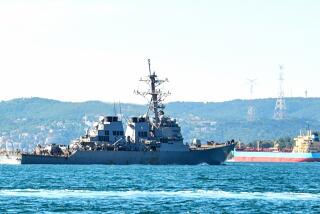A New Dimension in WWII Naval Warfare
- Share via
The Yamato, a Japanese superbattleship sunk by American warplanes during the waning days of World War II, met a slightly better fate Sunday in a small pond in Chino.
Under a barrage of enemy fire, the ship, keeling slightly and dangerously exposing its perforated starboard, made it just in time to port and safety.
“She’s never been hurt this bad,” lamented the ship’s “captain,” Alex McKail, 34, of Los Angeles.
Luckily for McKail, his ship could be temporarily fixed with some masking tape.
Welcome to Big Gun Warship Combat.
In the name of history and just pure fun, naval combat buffs from Australia to Albion, Ind., are building scale models of World War II warships just to have them riddled in emulated warfare with ball bearings.
An offspring of more common radio control hobbies like model planes and ships, the new pastime is quickly growing in popularity thanks to the Internet and attracting those who never quite outgrew their childhood dreams.
“I was looking for something to do in the sense of model building because I was bored with airplanes,” said Richard Hargrave, a 52-year-old graphic designer and “commanding officer” of the South Coast Battle Group, a Southern California club that meets once a month at Prado Regional Park in Chino.
Hargrave first got hooked in 1983 when he read an article about radio control combat in a specialty magazine.
“I couldn’t believe it,” he said. “I had fantasized about it for decades.”
And Big Gun Warship Combat meetings are a mixture of history lesson and a showcase in ingenuity.
The players can spout historical facts about their ships on cue and are all happy to show the intricate engineering they require.
Steve Gamble, a 46-year-old bar manager from Anaheim, explained the historical significance of his Tirpitz.
“It was the sister ship of the Bismarck [one of the biggest and most feared German battleships],” he said. “There were only two made.”
*
Gamble, along with McKail and Hargrave and about 20 club members and their ships, which can measure up to eight feet in length, showed up for Sunday’s meet.
Gamble said it took eight months to build his Tirpitz.
“If we start counting [the hours], we’d quit in a hurry,” joked Gamble’s friend, Randy Thorne, 40, a postal worker from Anaheim Hills.
Gamble’s Tirpitz includes three air systems and torpedo launchers mounted on each side.
“It is the heaviest armed ship in RC combat,” he boasted. Pointing to other models, he joshed that they were just “paperweights.”
The ships, 1/144 scale models of the real things, are equipped with electric motors, radio-controlled rudders, water pumps, and different caliber CO2-powered cannons that emulate conditions on a real battleship.
Most of the players build their ships from scratch, and they can cost as little as $200 for a cargo ship to Gambles’ Tirpitz, which cost $2,000 to build. The ships are reusable and players are divided into opposing Axis and Allies teams for each combat, which last about two hours.
Historical accuracy is important, but Hargrave concedes sometimes exceptions have to be made for the sake of fun. On Sunday, the Allies were outmatched in numbers by the Axis, so McKail, the Yamato’s captain, actually fought on the side of the Allies.
A mind-boggling set of rules dictates everything from the type of materials to be used on the boats to relative nautical speeds to the thickness of the hulls.
“You have to keep a fairly level playing field,” Hargrave said. “People put a lot of effort into their boats. You don’t want them to go home with their tail between their legs. There is no super weapon, or killer ship.
“When you put your model in the water, you really don’t know what’s gonna happen,” he said.
“You see pieces flying all over the place,” McKail said. “It is just fascinating.”
*
Big Gun is an outshoot of a more popular format of model combat that began in the mid-’70s in Texas, said Steve Milholland, owner of Swampworks Manufacturing, a company in Springfield, Mo., that produces ready-to-assemble kits for combat model ships.
The International RC Warship Combat Club plays by different rules than Big Gun and has about 300 members worldwide. The ships are faster and they only fire BBs.
The Big Gun format has more than 100 players in clubs across the United States and Australia, and clubs are forming in Europe, Randy Keher, a member of South Coast Battle Group, said.
Both have been growing fast with Internet home pages dedicated to the hobby.
Whichever format one prefers, the appeal is pretty clear. It is a chance “to build ships and pound the heck out of them,” said Brian Eliassen, of Pasadena.
More to Read
Sign up for The Wild
We’ll help you find the best places to hike, bike and run, as well as the perfect silent spots for meditation and yoga.
You may occasionally receive promotional content from the Los Angeles Times.






